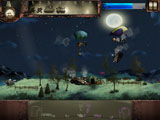Plasma Pong: Fluid Dynamics in a Pong Game
Plasma Pong is a mesmerizing freeware title by Steve Taylor, a student at George Mason University. It combines a cutting-edge realtime fluid dynamics simulation with the game structure of pong. Steve’s describes the game as follows:
Players have several new abilities that add fun twists to the classic game. In the game you can inject plasma fluid into the environment, create a vacuum from your paddle, and blast shockwaves into the playing area. All these abilities have fluid-based kinetic effects on the ball, making Plasma Pong a fast-paced and exciting game.
Gameplay
There isn’t a whole lot to say about the gameplay in Plasma Pong, really. The game structure mirrors that of the original Pong: You score if the ball makes it past your opponent’s paddle and vice versa.
The right-mouse button creates a vacuum and sucks the ball towards you. This is a great way to safely catch the ball, as the fluid dynamics tend to create sudden unpredictable movements as the ball gets caught in eddies and currents.
Left-mouse button fires plasma which shoots into the playfield. It can be used to push the ball for some extra speed, but also modify the currents. If you can succesfully create an eddy near the opponent’s side you can usually score when the ball makes sudden last-second movements.
Questionable Intentions
Despite its advanced physics simulation, I found myself playing Plasma Pong as I would nearly any pong game. It’s hard to use the fluid dynamics in a deliberate way to your advantage. This is kind of a shame, because if the game were more easily able to manifest my intentions as a player I think it would be much more addictive. As it stands now, though, the player experience flattens out to mere repetition after a few minutes.
I would have loved to see obstacles like walls, wave machines, powerups, or other changes to the mundane back-and-forth mechanic. To be fair, the game is a pong clone, but so much more could be done with the simulation engine. Maybe a fluid dynamics-based shooter?
Visuals
The game is a visual treat, at least. It’s almost as fun to play the game itself as it is to simply watch the physics simulation. In fact, you can press F1 to toggle over to an interactive fluid simulation that does away with the pong ball and paddles completely. I played with this almost as long as I played with the game itself.


(Plasma Pong Game Screenshots)
It’s Free
Plasma Pong is free; why aren’t you playing it already? It’s a neat example of using real-time fluid dynamics to replace the physics of an existing game. The result is half physics game, half graphics demo. It’s an interesting study–what would you change as a designer to add more depth to the experience?
Download Plasma Pong game (6.56 MB), or head over to the official Plasma Pong site.
Related Posts:
Steam Brigade: Physics in a Side-Scrolling RTS
Steam Brigade is Pedestrian Entertainment’s debut game, and it’s certainly a great first product for a studio. They concisely describe Steam Brigade as a side-scrolling, real-time strategy game set in an alternate history where airships and steam-powered tanks rule the battlefield. Principally, the game is one of strategy–choosing which units to spawn for which situations. The only way to interact with units once they are spawned, though, is to physically interact with them.
Real-Time Strategy Redefined
Typically a “real-time strategy game” brings to mind doling out orders to units: move here, attack that, defend this. Steam Brigade does away with unit management in the abstract. Once you spawn a tank or foot soldier they’re completely autonomous.
Your units aren’t totally helpless, though. You, the player, pilot an airship. It’s a fragile thing–you can’t shoot, or bomb, or really do much damage at all. You can, however, pick up units with a rather large magnet hanging off the ship. This is how you interact with your troops after they’ve spawned. You can whisk a unit to the front lines, dangle a still-firing tank from your underbelly, and even pick up enemy units to drop them to splattering results.
Steam Brigade Strategies
Steam Brigade’s strategy reminds me of Gearheads, an old PC game. Units are set up in a roshambo arrangement: soldiers kill engineers, tanks kill soldiers, turrets kill tanks (an engineer is required to operate a turret), and so on. Successfully conquering an enemy position requires planning and some personal intervention with the airship. You need to send over the right combination of troops, but also ensure their survival.
Resources
Unlike most real-time strategy games, Steam Brigade does away with finite resources. It takes money to purchase units, but unlimited money flows in for free at a steady rate. You can even purchase a new airship for yourself if you manage to get shot down. The game can be hard, though, and certainly requires concentration. If you carelessly spawn units as your money trickles it’s very easy to become deadlocked in your advances. It’s usually better to think a bit, wait for your money pile to max out, and go for one big push.
AI and Frustration
The AI in Steam Brigade is pretty crafty. This is both good and bad. It’s bad because it quickly becomes frustrating to have your efforts constantly thwarted by the opposing airship. It’s good in a way, though, because the AI demonstrates a lot of the advanced physics techniques. Of course, it demonstrates these techniques by crushing you ever so gently.
Where’s the Physics?
Now, Steam Brigade doesn’t perfectly fit into my rough definition of a physics game. I like to call something a physics game when the primary means by which you interact with the game is through manipulation of a complex physics system. Steam Brigade’s physics, although they are driven by Newton Game Dynamics, aren’t exactly complex. And the primary gameplay interaction is actually deciding which units to spawn (although physics interaction is definitely where most of your actual time).
So why am I talking about it? Well, for one, the game is neat. I think it deserves some attention. But more importantly, I’d love to see a concept like this with more emphasis on physics. I think there’s huge potential for an updated Gearheads concept where opposing forts spit out physics contraptions at each other to do battle. Steam Brigade hints at this with physics-based tricks and techniques, but it would be great to have something conceptualized from the ground up as a physics-based game with a similar premise.


(Steam Brigade Game Screenshots)
Try it Out!
Steam Brigade’s pacing is a little slow, but it’s a unique game with solid production. If you’re looking for some physics fun in a 2D environment, and aren’t afraid of a little thinking, definitely give it a try today.
Download the game demo over at Pedestrian Entertainment’s Steam Brigade page (21.5 MB). The full version is $19.95. Well worth it!
Related Posts:
- Hammerfight (Hammerfall) Now Available on Steam
- Garry’s Mod Launches on Steam
- Rag Doll Kung Fu Headed to Retail
- List of Physics Games
- Trials 2SE Visual Upgrade, Same Great Physics


 (Rate this game! 221 votes, average: 4.02 out of 5)
(Rate this game! 221 votes, average: 4.02 out of 5)
 My name is Matthew Wegner, and this site is dedicated to physics games.
My name is Matthew Wegner, and this site is dedicated to physics games.